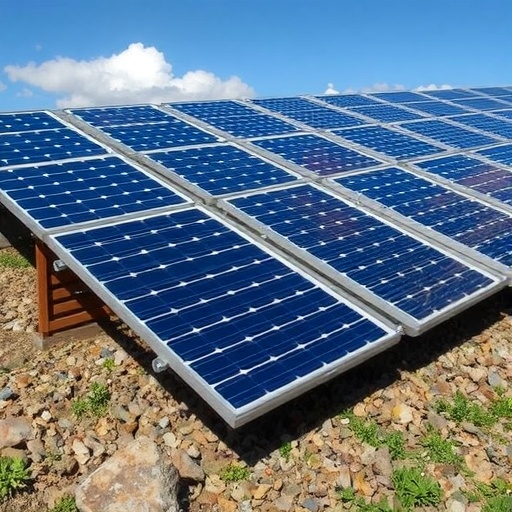A groundbreaking development in the quest for clean, sustainable energy has emerged from a team of researchers in South Korea, who have charted an innovative path toward the commercial viability of perovskite solar cells (PSCs). This new roadmap, which integrates cutting-edge artificial intelligence (AI) with eco-friendly manufacturing processes, promises not only to reduce costs dramatically but also to minimize environmental impact, signaling a significant leap forward in green energy technology. Highlighted as the cover story of the prestigious journal Green Chemistry, this study is anticipated to accelerate the global shift toward renewable energy.
Solar energy has long held the promise of an abundant and renewable source of clean power, essential for reducing greenhouse gas emissions and combating climate change. Among various solar technologies, perovskite solar cells have recently captured the gaze of researchers due to their exceptional theoretical efficiency, potentially reaching up to 34%. This efficiency surpasses that of conventional silicon-based solar cells, positioning PSCs as a next-generation photovoltaic technology. However, challenges related to the use of toxic solvents during fabrication and limited long-term stability have stalled large-scale commercialization efforts.
To address these barriers, the research collaboration between Pohang University of Science and Technology (POSTECH) and the University of Seoul has focused on replacing harmful chemical solvents with sustainable bio-based alternatives. Traditionally, the solvent dimethylformamide (DMF) has been employed in PSC fabrication but its toxicity poses significant risks to both human health and the environment. The novel approach substitutes DMF with gamma-valerolactone (GVL) and ethyl acetate (EA), solvents derived from biomass that are far less hazardous, thus forging a safer and greener manufacturing path.
At the heart of this breakthrough lies sophisticated AI-driven reverse engineering methodologies. By mining extensive experimental datasets, the AI engine effectively deduces the optimal processing parameters that maximize the PSC performance while simultaneously curtailing production costs and ecological footprints. This intricate balance between efficiency, safety, and sustainability exemplifies how artificial intelligence is revolutionizing materials design, not merely by accelerating discovery but also by facilitating environmentally responsible innovation.
Subsequent validation experiments according to AI-predicted conditions affirmed notable improvements in PSC fabrication. The team further developed a comprehensive sustainability evaluation model accounting for three critical aspects: manufacturing costs, environmental impact, and process efficiency. This holistic framework enables a systemic understanding of how new fabrication processes influence lifecycle emissions and economics, providing vital insights for scaling up production while maintaining green chemistry principles.
Remarkably, the adoption of the GVL-EA solvent system resulted in a halving of the manufacturing costs compared to conventional methods, alongside an 80 percent reduction in carbon emissions linked to the fabrication process. Such a profound decrease in climate impact underscores the immense potential bio-solvents have to transform renewable energy technologies into commercially and ecologically viable solutions. These gains also resonate with global goals targeting sustainable industrial development and carbon neutrality.
A nuanced element of this study involves the incorporation of module lifespan and recycling strategies within the sustainability assessment. The researchers emphasize that considering these factors collectively is key to pinpointing the actual break-even points for PSC commercialization in various geographical regions. This insight is crucial since regional disparities in recycling infrastructure and environmental policies will influence the economic feasibility and environmental benefits of PSC deployment on a global scale.
Professor Jeehoon Han of POSTECH, who led the initiative, highlighted the innovative use of AI, remarking that it uncovered process optimizations previously deemed unattainable. By enabling conditions that enhance safety, affordability, and performance simultaneously, AI emerged as a transformative tool for manufacturing design in energy technologies. This integration of advanced computation with eco-friendly chemistry paves the way for industrialization of PSCs on a scale adequate to influence energy markets.
Importantly, the move toward non-toxic, biomass-derived solvents addresses not only the environmental concerns but also health and safety regulations that could otherwise hinder PSC adoption. This makes the solar cells safer for manufacturers and end-users alike. In a broader sense, such advances contribute to a circular economy model where renewable materials and green processes become standard practice rather than exceptions.
The societal and environmental implications of this study extend beyond academia; they resonate strongly with policy makers and industry stakeholders aiming to incentivize sustainable innovation. The Korean Ministry of Science and ICT, among other agencies, supported the research through programs dedicated to developing eco-friendly chemicals and supporting early-career researchers. This reflects a strategic alignment between government priorities and scientific progress in tackling climate change through technological innovation.
Looking forward, integrating AI with sustainable chemistry is likely to become a defining trend in materials science, enabling more rapid and responsible discovery cycles. The ability to predict and validate environmentally benign processes accelerates technology readiness levels, diminishing the gap from laboratory discoveries to commercial products. For perovskite solar cells, this roadmap signifies a key stepping stone toward widespread market adoption, ultimately contributing to a cleaner, more sustainable energy future.
In summation, the amalgamation of biomass-derived solvent processes and AI-empowered optimization offers a compelling vision for the advancement of perovskite solar cells. This approach not only catalyzes process innovation but also reinforces the critical nexus between technology and environmental stewardship. As the global community intensifies its efforts to reduce carbon footprints, such pioneering research serves as a beacon illuminating the possibilities of greener, smarter, and more efficacious solar energy technologies.
Subject of Research: Sustainable perovskite solar cell fabrication using bio-based solvents optimized through AI technology.
Article Title: Advancing perovskite solar cells with biomass-derived solvents: a pathway to sustainability
News Publication Date: 28-Jul-2025
Web References: DOI link
Image Credits: POSTECH
Keywords: Applied sciences and engineering, Computer science, Artificial intelligence, Optoelectronics, Hybrid solar cells, Solar power, Photovoltaics, Electrical power generation, Solar fuels, Pollutants, Greenhouse effect, Carbon emissions, Mineralogy, Perovskites, Chemical compounds, Solvents




